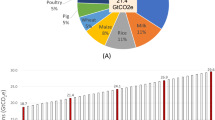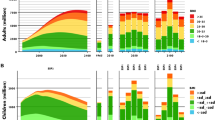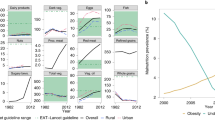Abstract
Ending hunger is a Sustainable Development Goal of the UN. However, feeding a growing world population by increasing food production without implementing more sustainable consumption will threaten the environment. We explore alternative hunger eradication scenarios that do not compromise environmental protection. We find that an economy-growth-oriented scenario, which ignores inequitable food distribution and is aimed at ending hunger by increasing overall food availability, would require about 20% more food production, 48 Mha of additional agricultural land and would increase greenhouse gas emissions by 550 Mt of CO2 equivalents yr−1 in 2030, compared with the business-as-usual scenario. If hunger eradication efforts were focused solely on the under-nourished, food demand would increase by only 3%, and the associated environmental trade-offs would be largely reduced. Moreover, a combined scenario that targets the under-nourished while also reducing over-consumption, food waste, agricultural intensification and other environmental impacts would reduce food demand by 9% compared with the business-as-usual scenario and would lead to the multiple benefits of reducing hunger and contributing to environmental sustainability.
This is a preview of subscription content, access via your institution
Access options
Access Nature and 54 other Nature Portfolio journals
Get Nature+, our best-value online-access subscription
$29.99 / 30 days
cancel any time
Subscribe to this journal
Receive 12 digital issues and online access to articles
$119.00 per year
only $9.92 per issue
Buy this article
- Purchase on Springer Link
- Instant access to full article PDF
Prices may be subject to local taxes which are calculated during checkout



Similar content being viewed by others
Data availability
The data repository, including scenario data, is stored on Harvard Dataverse (https://doi.org/10.7910/DVN/RQZELX).
Code availability
The authors declare that the program code used to generate results in this study is available from the corresponding author on request.
Change history
11 November 2019
An amendment to this paper has been published and can be accessed via a link at the top of the paper.
References
The State of Food Security and Nutrition in the World 2017: Builiding Resilience for Peace and Food Security (FAO, UNICEF, WFP, WHO, 2017).
IAASTD: International Assessment of Agricultural Knowledge, Science and Technology for Development Global Report (Island, 2009).
Alexandratos, N. & Bruinsma, J. World Agriculture Towards 2030/2050: The 2012 Revision (FAO, 2012).
FAOSTAT (FAO, 2017); http://www.fao.org/faostat/en/#home
Maxwell, S. L., Fuller, R. A., Brooks, T. M. & Watson, J. E. M. Biodiversity: The ravages of guns, nets and bulldozers. Nature 536, 143–145 (2016).
Shiklomanov, I. A. Appraisal and assessment of world water resources. Water Int. 25, 11–32 (2000).
Smith, P. M. B. et al. in Climate Change 2014: Mitigation of Climate Change (eds Edenhofer, O. et al.) 811–922 (Cambridge Univ. Press, 2014).
Rockstrom, J. et al. A safe operating space for humanity. Nature 461, 472–475 (2009).
Obersteiner, M. et al. Assessing the land resource–food price nexus of the Sustainable Development Goals. Sci. Adv. 2, e1501499 (2016).
Foley, J. A. et al. Solutions for a cultivated planet. Nature 478, 337–342 (2011).
Rosegrant, M. W. S. et al. Quantitative Foresight Modeling to Inform the CGIAR Research Portfolio (International Food Policy Research Institute, 2017).
Erb, K.-H. et al. Exploring the biophysical option space for feeding the world without deforestation. Nat. Commun. 7, 11382 (2016).
Nelson, G. C. et al. Food Security, Farming, and Climate Change to 2050: Scenarios, Results, Policy Options (International Food Policy Research Institute, 2010).
Muller, A. et al. Strategies for feeding the world more sustainably with organic agriculture. Nat. Commun. 8, 1290 (2017).
Springmann, M. et al. Options for keeping the food system within environmental limits. Nature 562, 519–525 (2018).
Cafiero, C. Advances in Hunger Measurement: Traditional FAO Methods and Recent Innovations (FAO, 2014).
The State of Food Insecurity in the World Meeting the 2015 International Hunger Targets: Taking Stock of Uneven Progress (FAO, 2015).
The CELAC Plan for Food and Nutrition Security and the Eradication of Hunger 2025: Executive Summary (FAO, ECLAC, ALADI, 2015).
CELAC Food Security, Nutrition and Hunger Eradication 2025: Matters for Discussion and Regional Cooperation (FAO, 2016).
Drèze, J. & Sen, A. Hunger and Public Action (Oxford Univ. Press, 1989).
Gobin, V. J., Santos, P. & Toth, R. No longer trapped? Promoting entrepreneurship through cash transfers to ultra-poor women in northern Kenya. Am. J. Agric. Econ. 99, 1362–1383 (2017).
Burney, J. A., Davis, S. J. & Lobell, D. B. Greenhouse gas mitigation by agricultural intensification. Proc. Natl Acad. Sci. USA 107, 12052–12057 (2010).
Valin, H. et al. Agricultural productivity and greenhouse gas emissions: trade-offs or synergies between mitigation and food security? Environ. Res. Lett. 8, 035019 (2013).
Hasegawa, T. et al. Consequence of climate mitigation on the risk of hunger. Environ. Sci. Technol. 49, 7245–7253 (2015).
Hasegawa, T., Fujimori, S., Takahashi, K. & Masui, T. Scenarios for the risk of hunger in the twenty-first century using Shared Socioeconomic Pathways. Environ. Res. Lett. 10, 014010 (2015).
Havlík, P. et al. Climate change mitigation through livestock system transitions. Proc. Natl Acad. Sci. USA 111, 3709–3714 (2014).
Lin, B.-H., Smith, T. A., Lee, J.-Y. & Hall, K. D. Measuring weight outcomes for obesity intervention strategies: the case of a sugar-sweetened beverage tax. Econ. Hum. Biol. 9, 329–341 (2011).
Springmann, M., Godfray, H. C. J., Rayner, M. & Scarborough, P. Analysis and valuation of the health and climate change cobenefits of dietary change. Proc. Natl Acad. Sci. USA 113, 4146–4151 (2016).
Duffey, K. J. et al. Food price and diet and health outcomes: 20 years of the CARDIA study. Arch. Intern. Med. 170, 420–426 (2010).
Colchero, M. A., Popkin, B. M., Rivera, J. A. & Ng, S. W. Beverage purchases from stores in Mexico under the excise tax on sugar sweetened beverages:observational study. BMJ 352, h6704 (2016).
Global Food Losses and Food Waste—Extent, Causes and Prevention (FAO, 2011).
Legge sugli sprechi alimentari (Legge 19 agosto 2016 n.166): Disposizioni concernenti la donazione e la distribuzione di prodotti alimentari e farmaceutici a fini di solidarieta’ sociale e per la limitazione degli sprechi (16G00179) GU Serie Generale n.202 del 30-08-2016 (Gazzetta Ufficiale della Republicca Italiana, 2016); http://www.gazzettaufficiale.it/eli/id/2016/08/30/16G00179/sg
Herrero, M. et al. Biomass use, production, feed efficiencies, and greenhouse gas emissions from global livestock systems. Proc. Natl Acad. Sci. USA 110, 20888–20893 (2013).
Fricko, O. et al. The marker quantification of the Shared Socioeconomic Pathway 2: a middle-of-the-road scenario for the 21st century. Glob. Environ. Change 42, 251–267 (2017).
Frank, S. et al. Reducing greenhouse gas emissions in agriculture without compromising food security? Environ. Res. Lett. 12, 105004 (2017).
Resolution Adopted by the General Assembly on Work of the Statistical Commission Pertaining to the 2030 Agenda for Sustainable Development A/RES/71/313 (UN, 2017).
AQUASTAT Main Database (FAO, 2016).
Food Security Indicators (FAO, 2016); http://www.fao.org/economic/ess/ess-fs/ess-fadata/en/#.V7KYqpgqq9I
Rand, W. M., Pellett, P. L. & Young, V. R. Meta-analysis of nitrogen balance studies for estimating protein requirements in healthy adults. Am. J. Clin. Nutr. 77, 109–127 (2003).
Protein and Amino Acid Requirements in Human Nutrition: Report of a Joint FAO/WHO/UNU Expert Consultation (WHO, FAO, UNU, 2007).
Walpole, S. C. et al. The weight of nations: an estimation of adult human biomass. BMC Public Health 12, 439 (2012).
Energy and Protein Requirements (FAO, WHO, 1973).
Shared Socioeconomic Pathways (SSP) Database Version 0.9.3 (IIASA, accessed 1 August 2012); https://tntcat.iiasa.ac.at/SspDb
Acknowledgements
T.H. is supported by JSPS Overseas Research Fellowships and Global Environmental Research Fund 2–1702 of the Ministry of Environment of Japan. P.H., S.F. and H.V. are supported by the H2020 SUSFANS project—Metrics, Models and Foresight for European Sustainable Food and Nutrition Security under grant agreement no. 633692. P.H., A.P., S.F. and H.V. are supported by the UNIDO IS-WEL project—Integrated Solutions for Water, Energy and Land under grant no. 140312. T.H. is grateful to IIASA and NIES for the opportunity to visit IIASA and for this collaborative work with IIASA colleagues.
Author information
Authors and Affiliations
Contributions
T.H. and P.H. designed the research and carried out the analysis of the modelling results. T.H. created figures and led the writing of the paper. All authors contributed to the discussion and interpretation of the results and to writing the paper.
Corresponding author
Ethics declarations
Competing interests
The authors declare no competing interests.
Additional information
Publisher’s note Springer Nature remains neutral with regard to jurisdictional claims in published maps and institutional affiliations.
Supplementary information
Supplementary information
Supplementary Figs. 1–7, Table 1, methods and references.
Rights and permissions
About this article
Cite this article
Hasegawa, T., Havlík, P., Frank, S. et al. Tackling food consumption inequality to fight hunger without pressuring the environment. Nat Sustain 2, 826–833 (2019). https://doi.org/10.1038/s41893-019-0371-6
Received:
Accepted:
Published:
Issue Date:
DOI: https://doi.org/10.1038/s41893-019-0371-6
This article is cited by
-
Health burden from food systems is highly unequal across income groups
Nature Food (2024)
-
Justice considerations in climate research
Nature Climate Change (2024)
-
Systematic scenario modeling for priority assessment of sustainable development goals in China under interaction and uncertainty
Environment, Development and Sustainability (2024)
-
Feeding climate and biodiversity goals with novel plant-based meat and milk alternatives
Nature Communications (2023)
-
Enhanced food system efficiency is the key to China’s 2060 carbon neutrality target
Nature Food (2023)



